Tipping and Its Effects on Restaurant Business: An Analysis
VerifiedAdded on 2022/11/03
|6
|1343
|105
Essay
AI Summary
This essay delves into the multifaceted effects of tipping in the restaurant industry. It begins by tracing the historical origins of tipping and then explores its contemporary implications. The essay critically examines the advantages and disadvantages of tipping, highlighting how tipping affects both customers and restaurant owners. It discusses the shift towards service charges and the impact of tipping on employee earnings and job satisfaction. The essay also touches upon the influence of factors like race, gender, and accent on tipping behavior and the challenges faced by budget restaurants. The analysis draws on various research studies, including the works of Lynn and others, to provide a comprehensive understanding of the complexities surrounding tipping practices. Ultimately, the essay concludes that tipping, while deeply ingrained in some cultures, presents a range of challenges and may be viewed as a discriminatory practice, affecting both customers and restaurant owners.
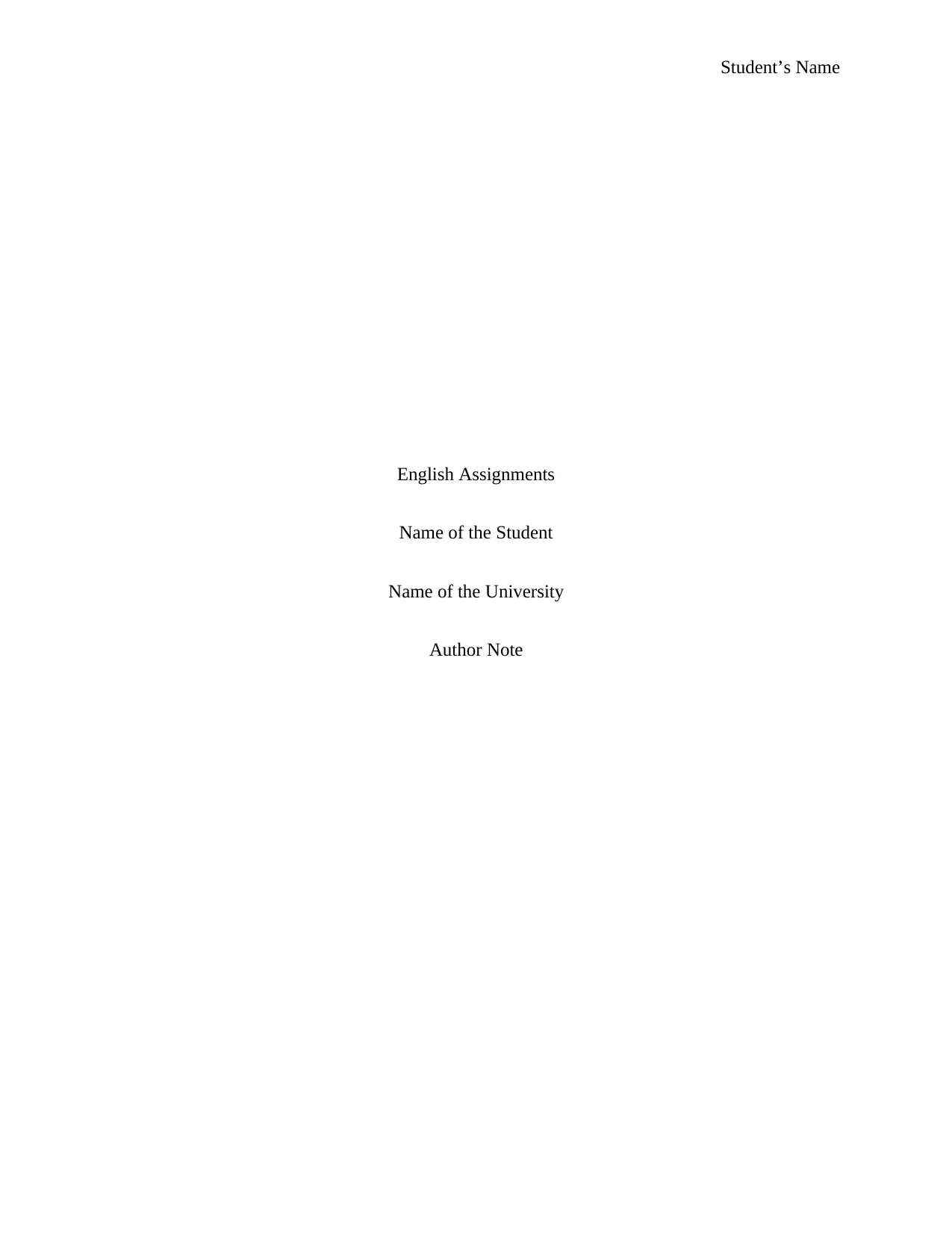
Student’s Name
English Assignments
Name of the Student
Name of the University
Author Note
English Assignments
Name of the Student
Name of the University
Author Note
Paraphrase This Document
Need a fresh take? Get an instant paraphrase of this document with our AI Paraphraser
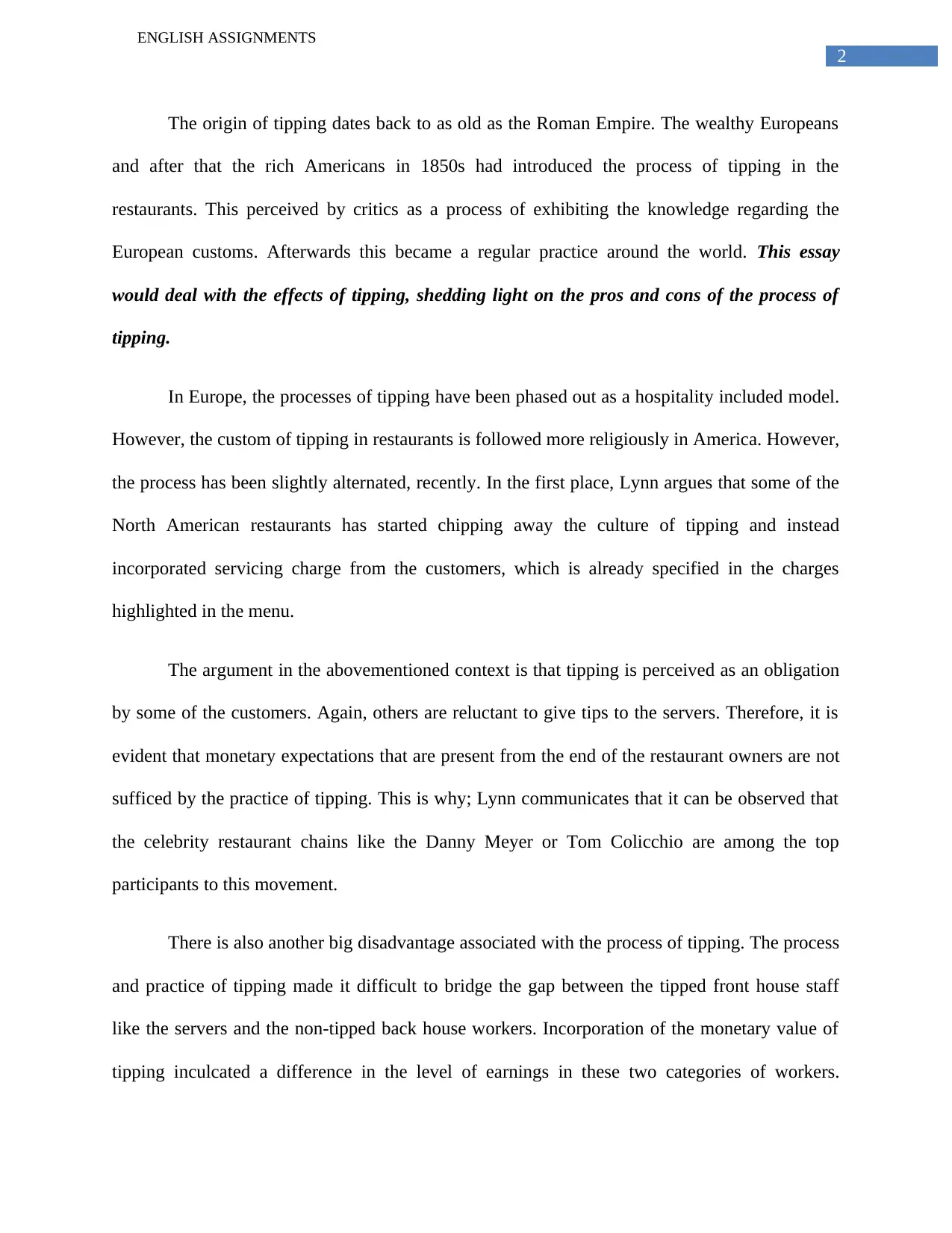
2
ENGLISH ASSIGNMENTS
The origin of tipping dates back to as old as the Roman Empire. The wealthy Europeans
and after that the rich Americans in 1850s had introduced the process of tipping in the
restaurants. This perceived by critics as a process of exhibiting the knowledge regarding the
European customs. Afterwards this became a regular practice around the world. This essay
would deal with the effects of tipping, shedding light on the pros and cons of the process of
tipping.
In Europe, the processes of tipping have been phased out as a hospitality included model.
However, the custom of tipping in restaurants is followed more religiously in America. However,
the process has been slightly alternated, recently. In the first place, Lynn argues that some of the
North American restaurants has started chipping away the culture of tipping and instead
incorporated servicing charge from the customers, which is already specified in the charges
highlighted in the menu.
The argument in the abovementioned context is that tipping is perceived as an obligation
by some of the customers. Again, others are reluctant to give tips to the servers. Therefore, it is
evident that monetary expectations that are present from the end of the restaurant owners are not
sufficed by the practice of tipping. This is why; Lynn communicates that it can be observed that
the celebrity restaurant chains like the Danny Meyer or Tom Colicchio are among the top
participants to this movement.
There is also another big disadvantage associated with the process of tipping. The process
and practice of tipping made it difficult to bridge the gap between the tipped front house staff
like the servers and the non-tipped back house workers. Incorporation of the monetary value of
tipping inculcated a difference in the level of earnings in these two categories of workers.
ENGLISH ASSIGNMENTS
The origin of tipping dates back to as old as the Roman Empire. The wealthy Europeans
and after that the rich Americans in 1850s had introduced the process of tipping in the
restaurants. This perceived by critics as a process of exhibiting the knowledge regarding the
European customs. Afterwards this became a regular practice around the world. This essay
would deal with the effects of tipping, shedding light on the pros and cons of the process of
tipping.
In Europe, the processes of tipping have been phased out as a hospitality included model.
However, the custom of tipping in restaurants is followed more religiously in America. However,
the process has been slightly alternated, recently. In the first place, Lynn argues that some of the
North American restaurants has started chipping away the culture of tipping and instead
incorporated servicing charge from the customers, which is already specified in the charges
highlighted in the menu.
The argument in the abovementioned context is that tipping is perceived as an obligation
by some of the customers. Again, others are reluctant to give tips to the servers. Therefore, it is
evident that monetary expectations that are present from the end of the restaurant owners are not
sufficed by the practice of tipping. This is why; Lynn communicates that it can be observed that
the celebrity restaurant chains like the Danny Meyer or Tom Colicchio are among the top
participants to this movement.
There is also another big disadvantage associated with the process of tipping. The process
and practice of tipping made it difficult to bridge the gap between the tipped front house staff
like the servers and the non-tipped back house workers. Incorporation of the monetary value of
tipping inculcated a difference in the level of earnings in these two categories of workers.
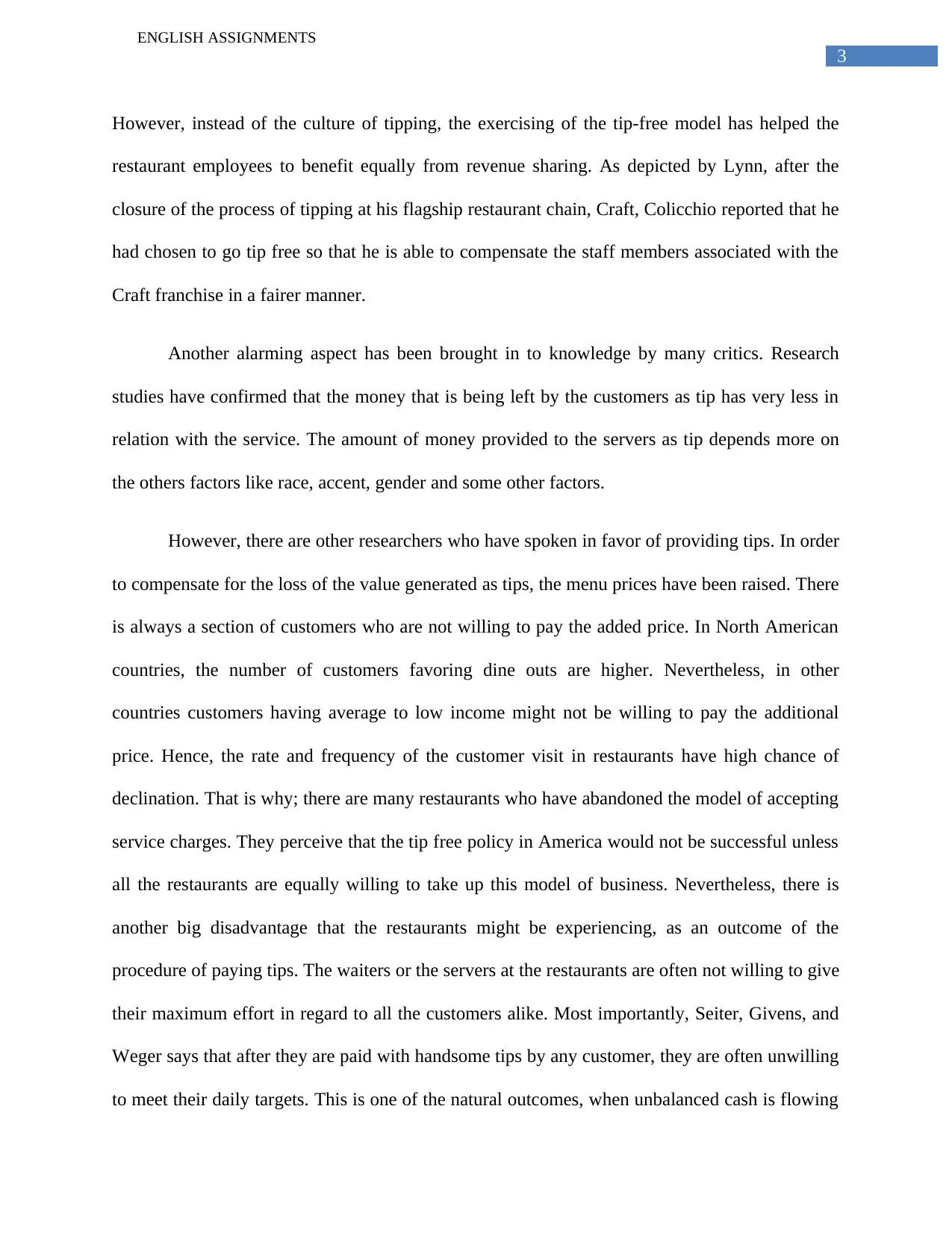
3
ENGLISH ASSIGNMENTS
However, instead of the culture of tipping, the exercising of the tip-free model has helped the
restaurant employees to benefit equally from revenue sharing. As depicted by Lynn, after the
closure of the process of tipping at his flagship restaurant chain, Craft, Colicchio reported that he
had chosen to go tip free so that he is able to compensate the staff members associated with the
Craft franchise in a fairer manner.
Another alarming aspect has been brought in to knowledge by many critics. Research
studies have confirmed that the money that is being left by the customers as tip has very less in
relation with the service. The amount of money provided to the servers as tip depends more on
the others factors like race, accent, gender and some other factors.
However, there are other researchers who have spoken in favor of providing tips. In order
to compensate for the loss of the value generated as tips, the menu prices have been raised. There
is always a section of customers who are not willing to pay the added price. In North American
countries, the number of customers favoring dine outs are higher. Nevertheless, in other
countries customers having average to low income might not be willing to pay the additional
price. Hence, the rate and frequency of the customer visit in restaurants have high chance of
declination. That is why; there are many restaurants who have abandoned the model of accepting
service charges. They perceive that the tip free policy in America would not be successful unless
all the restaurants are equally willing to take up this model of business. Nevertheless, there is
another big disadvantage that the restaurants might be experiencing, as an outcome of the
procedure of paying tips. The waiters or the servers at the restaurants are often not willing to give
their maximum effort in regard to all the customers alike. Most importantly, Seiter, Givens, and
Weger says that after they are paid with handsome tips by any customer, they are often unwilling
to meet their daily targets. This is one of the natural outcomes, when unbalanced cash is flowing
ENGLISH ASSIGNMENTS
However, instead of the culture of tipping, the exercising of the tip-free model has helped the
restaurant employees to benefit equally from revenue sharing. As depicted by Lynn, after the
closure of the process of tipping at his flagship restaurant chain, Craft, Colicchio reported that he
had chosen to go tip free so that he is able to compensate the staff members associated with the
Craft franchise in a fairer manner.
Another alarming aspect has been brought in to knowledge by many critics. Research
studies have confirmed that the money that is being left by the customers as tip has very less in
relation with the service. The amount of money provided to the servers as tip depends more on
the others factors like race, accent, gender and some other factors.
However, there are other researchers who have spoken in favor of providing tips. In order
to compensate for the loss of the value generated as tips, the menu prices have been raised. There
is always a section of customers who are not willing to pay the added price. In North American
countries, the number of customers favoring dine outs are higher. Nevertheless, in other
countries customers having average to low income might not be willing to pay the additional
price. Hence, the rate and frequency of the customer visit in restaurants have high chance of
declination. That is why; there are many restaurants who have abandoned the model of accepting
service charges. They perceive that the tip free policy in America would not be successful unless
all the restaurants are equally willing to take up this model of business. Nevertheless, there is
another big disadvantage that the restaurants might be experiencing, as an outcome of the
procedure of paying tips. The waiters or the servers at the restaurants are often not willing to give
their maximum effort in regard to all the customers alike. Most importantly, Seiter, Givens, and
Weger says that after they are paid with handsome tips by any customer, they are often unwilling
to meet their daily targets. This is one of the natural outcomes, when unbalanced cash is flowing
⊘ This is a preview!⊘
Do you want full access?
Subscribe today to unlock all pages.

Trusted by 1+ million students worldwide
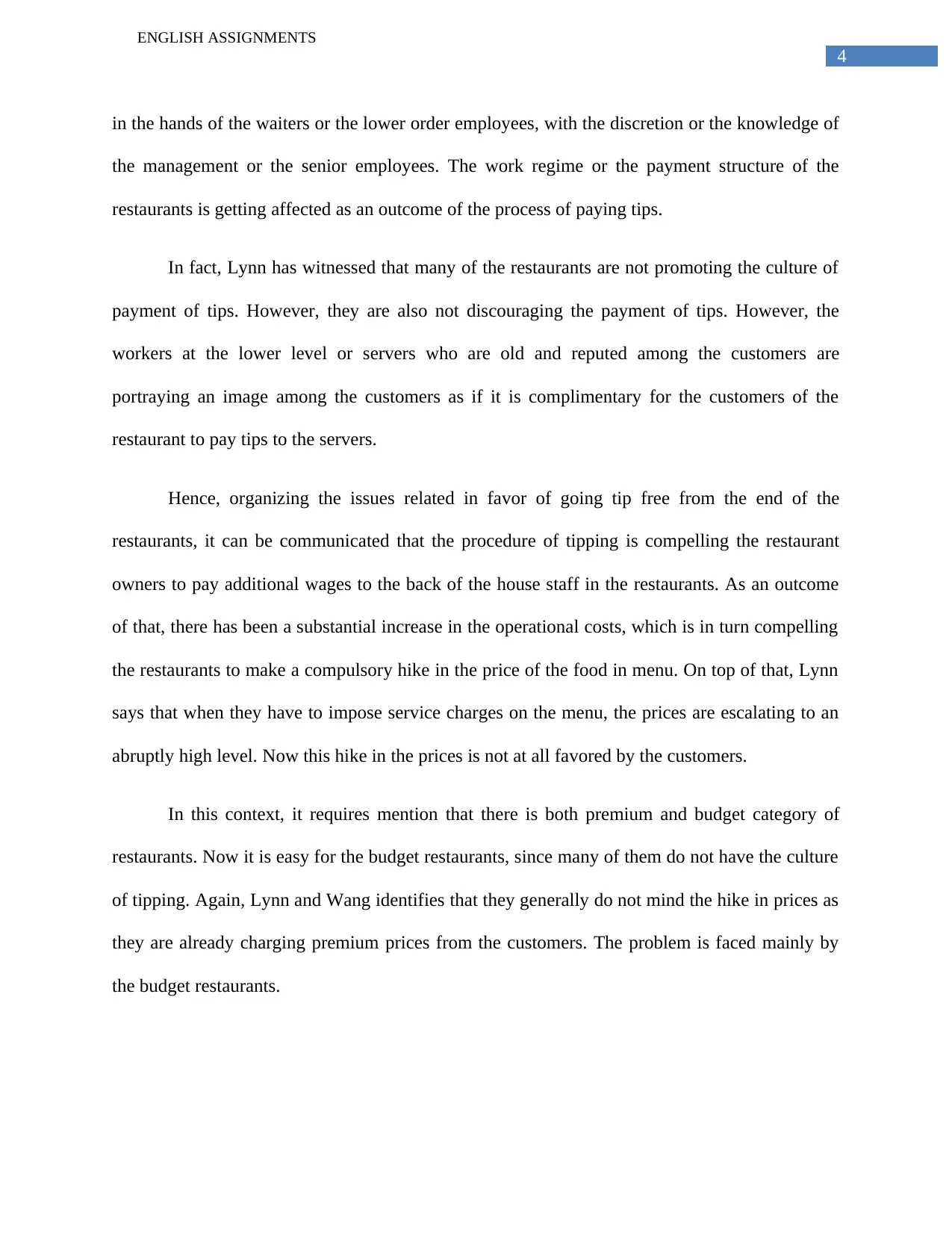
4
ENGLISH ASSIGNMENTS
in the hands of the waiters or the lower order employees, with the discretion or the knowledge of
the management or the senior employees. The work regime or the payment structure of the
restaurants is getting affected as an outcome of the process of paying tips.
In fact, Lynn has witnessed that many of the restaurants are not promoting the culture of
payment of tips. However, they are also not discouraging the payment of tips. However, the
workers at the lower level or servers who are old and reputed among the customers are
portraying an image among the customers as if it is complimentary for the customers of the
restaurant to pay tips to the servers.
Hence, organizing the issues related in favor of going tip free from the end of the
restaurants, it can be communicated that the procedure of tipping is compelling the restaurant
owners to pay additional wages to the back of the house staff in the restaurants. As an outcome
of that, there has been a substantial increase in the operational costs, which is in turn compelling
the restaurants to make a compulsory hike in the price of the food in menu. On top of that, Lynn
says that when they have to impose service charges on the menu, the prices are escalating to an
abruptly high level. Now this hike in the prices is not at all favored by the customers.
In this context, it requires mention that there is both premium and budget category of
restaurants. Now it is easy for the budget restaurants, since many of them do not have the culture
of tipping. Again, Lynn and Wang identifies that they generally do not mind the hike in prices as
they are already charging premium prices from the customers. The problem is faced mainly by
the budget restaurants.
ENGLISH ASSIGNMENTS
in the hands of the waiters or the lower order employees, with the discretion or the knowledge of
the management or the senior employees. The work regime or the payment structure of the
restaurants is getting affected as an outcome of the process of paying tips.
In fact, Lynn has witnessed that many of the restaurants are not promoting the culture of
payment of tips. However, they are also not discouraging the payment of tips. However, the
workers at the lower level or servers who are old and reputed among the customers are
portraying an image among the customers as if it is complimentary for the customers of the
restaurant to pay tips to the servers.
Hence, organizing the issues related in favor of going tip free from the end of the
restaurants, it can be communicated that the procedure of tipping is compelling the restaurant
owners to pay additional wages to the back of the house staff in the restaurants. As an outcome
of that, there has been a substantial increase in the operational costs, which is in turn compelling
the restaurants to make a compulsory hike in the price of the food in menu. On top of that, Lynn
says that when they have to impose service charges on the menu, the prices are escalating to an
abruptly high level. Now this hike in the prices is not at all favored by the customers.
In this context, it requires mention that there is both premium and budget category of
restaurants. Now it is easy for the budget restaurants, since many of them do not have the culture
of tipping. Again, Lynn and Wang identifies that they generally do not mind the hike in prices as
they are already charging premium prices from the customers. The problem is faced mainly by
the budget restaurants.
Paraphrase This Document
Need a fresh take? Get an instant paraphrase of this document with our AI Paraphraser
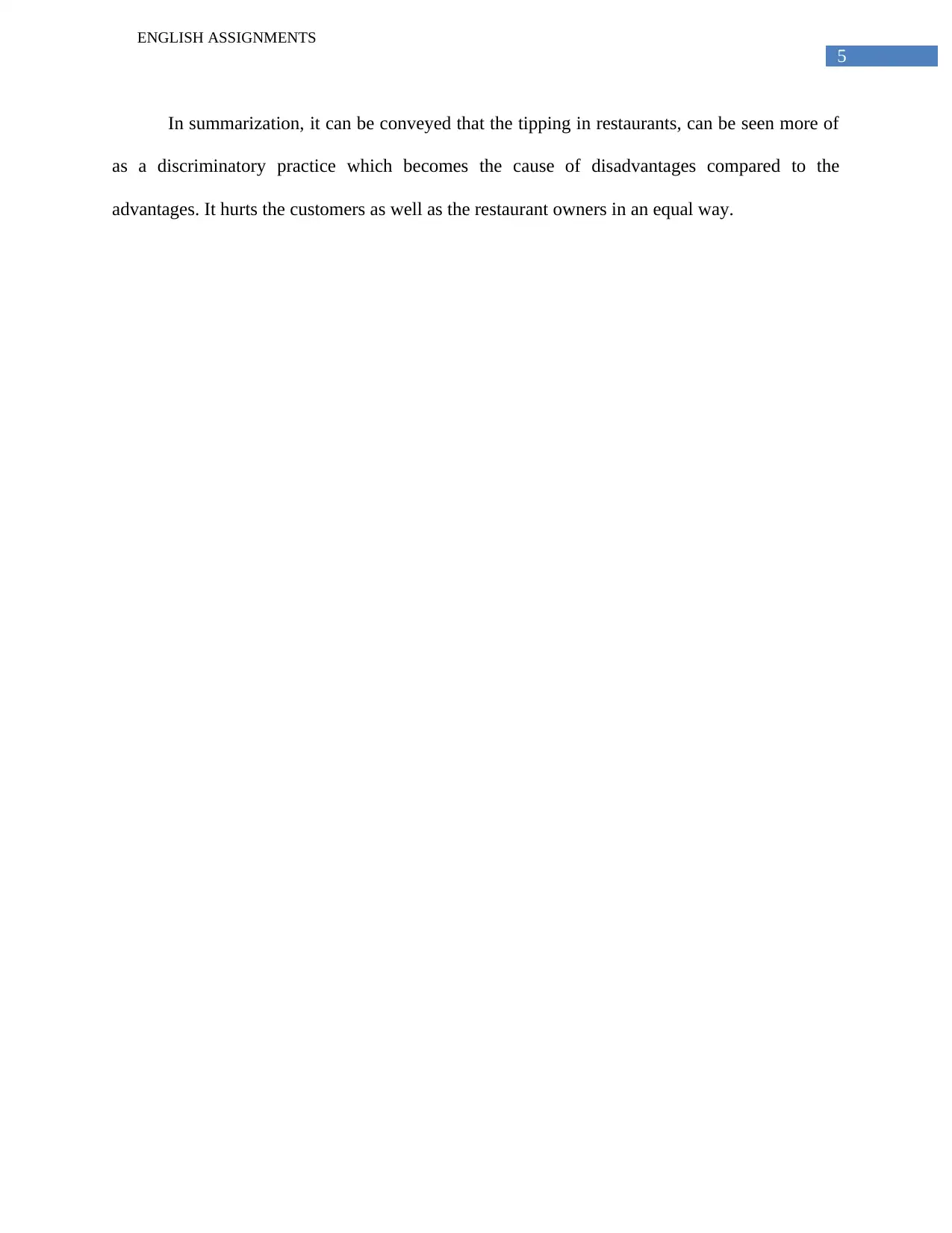
5
ENGLISH ASSIGNMENTS
In summarization, it can be conveyed that the tipping in restaurants, can be seen more of
as a discriminatory practice which becomes the cause of disadvantages compared to the
advantages. It hurts the customers as well as the restaurant owners in an equal way.
ENGLISH ASSIGNMENTS
In summarization, it can be conveyed that the tipping in restaurants, can be seen more of
as a discriminatory practice which becomes the cause of disadvantages compared to the
advantages. It hurts the customers as well as the restaurant owners in an equal way.
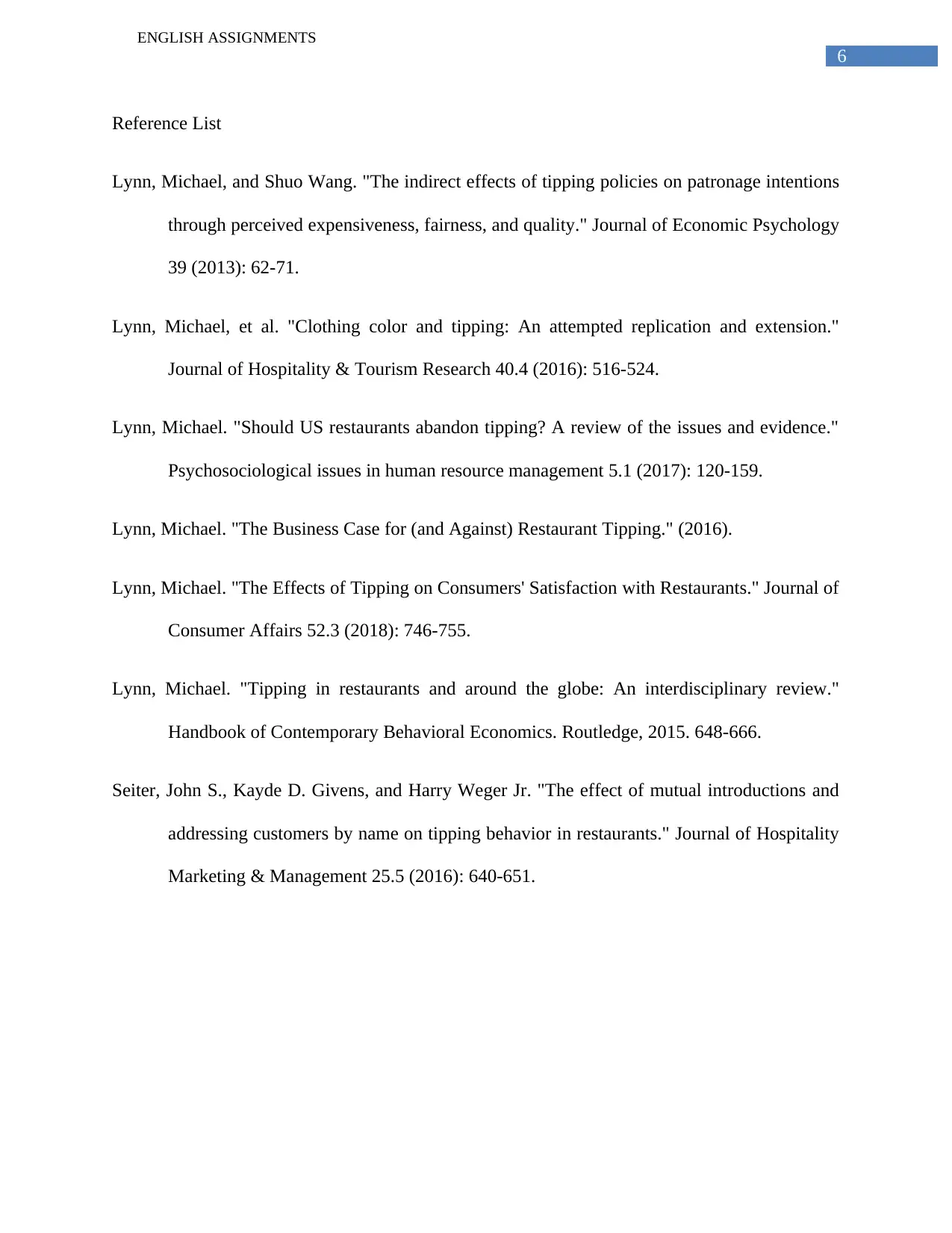
6
ENGLISH ASSIGNMENTS
Reference List
Lynn, Michael, and Shuo Wang. "The indirect effects of tipping policies on patronage intentions
through perceived expensiveness, fairness, and quality." Journal of Economic Psychology
39 (2013): 62-71.
Lynn, Michael, et al. "Clothing color and tipping: An attempted replication and extension."
Journal of Hospitality & Tourism Research 40.4 (2016): 516-524.
Lynn, Michael. "Should US restaurants abandon tipping? A review of the issues and evidence."
Psychosociological issues in human resource management 5.1 (2017): 120-159.
Lynn, Michael. "The Business Case for (and Against) Restaurant Tipping." (2016).
Lynn, Michael. "The Effects of Tipping on Consumers' Satisfaction with Restaurants." Journal of
Consumer Affairs 52.3 (2018): 746-755.
Lynn, Michael. "Tipping in restaurants and around the globe: An interdisciplinary review."
Handbook of Contemporary Behavioral Economics. Routledge, 2015. 648-666.
Seiter, John S., Kayde D. Givens, and Harry Weger Jr. "The effect of mutual introductions and
addressing customers by name on tipping behavior in restaurants." Journal of Hospitality
Marketing & Management 25.5 (2016): 640-651.
ENGLISH ASSIGNMENTS
Reference List
Lynn, Michael, and Shuo Wang. "The indirect effects of tipping policies on patronage intentions
through perceived expensiveness, fairness, and quality." Journal of Economic Psychology
39 (2013): 62-71.
Lynn, Michael, et al. "Clothing color and tipping: An attempted replication and extension."
Journal of Hospitality & Tourism Research 40.4 (2016): 516-524.
Lynn, Michael. "Should US restaurants abandon tipping? A review of the issues and evidence."
Psychosociological issues in human resource management 5.1 (2017): 120-159.
Lynn, Michael. "The Business Case for (and Against) Restaurant Tipping." (2016).
Lynn, Michael. "The Effects of Tipping on Consumers' Satisfaction with Restaurants." Journal of
Consumer Affairs 52.3 (2018): 746-755.
Lynn, Michael. "Tipping in restaurants and around the globe: An interdisciplinary review."
Handbook of Contemporary Behavioral Economics. Routledge, 2015. 648-666.
Seiter, John S., Kayde D. Givens, and Harry Weger Jr. "The effect of mutual introductions and
addressing customers by name on tipping behavior in restaurants." Journal of Hospitality
Marketing & Management 25.5 (2016): 640-651.
⊘ This is a preview!⊘
Do you want full access?
Subscribe today to unlock all pages.

Trusted by 1+ million students worldwide
1 out of 6
Your All-in-One AI-Powered Toolkit for Academic Success.
+13062052269
info@desklib.com
Available 24*7 on WhatsApp / Email
![[object Object]](/_next/static/media/star-bottom.7253800d.svg)
Unlock your academic potential
Copyright © 2020–2025 A2Z Services. All Rights Reserved. Developed and managed by ZUCOL.